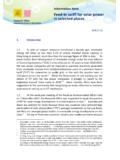Transcription of Adoption of 4G Mobile Services from the Female …
1 Malaysian Online Journal of Educational Technology 2015 (Volume 3 Issue 1) Adoption of 4G Mobile Services from the [1] College of Business and Administration, Female Student's perspective : case of Princess Nora University (PNU), Riyadh Princess Nora University Awni Rawashdeh [1] ABSTRACT The aim this study was to examine the relationship between the perceived usefulness, perceived ease of use, perceived entertainment, attitude and the users' intention toward using the fourth generation (4G) wireless Mobile Services . Data of this study were collected by survey with a cross sectional approach. The data were analyzed with factor analysis, as well as correlation and regression analyses. The findings reveal that the combination of perceived usefulness, perceived ease of use, perceived entertainment value and attitude are together responsible for determining the users' intention to use the 4G Mobile Services . However, the chief predicting factor influencing user intention to use the 4G Mobile Services is perceived entertainment value.
2 A study of the factors identified should result in a more successful Adoption of 4G. wireless Mobile Services , 4G, Adoption , technology acceptance Keywords: model (TAM), attitude, intention, AMOS, SEM INTRODUCTION. The fourth generation Mobile communication and technology service, 4G, is a combination of 3G and WLAN, with the ability to transmit high quality video images and image transmission comparable in quality to high definition television technology products (Haitao & Xiaomin, 2012). The 4G system can download at a speed of 100 Mbps, about a thousand times faster than the dial up Internet access, upload at 20 Mbps speed, and meet nearly all the user's requirements for wireless Services (Krikke, 2004; Yang, 2012). As users are most concerned about the cost, the 4G is comparable in price to the fixed broadband networks and the billing is more flexible, as users can determine the Services required depending on their needs (Pabst et al., 2004). Besides, 4G uses DSL and cable modems in those areas without deployment coverage, and then extends it to the rest of the areas.
3 Thus, 4G enjoys unmatched benefits. The Adoption of the 4G Mobile has showed steady growth across the world (Lee, Marcu, & Lee, 2011). However, a wide range of 4G diffusion levels is observed across countries. Saudi Arabia is in second place with no changes in its telecoms rating score (ITU, 2012). The 4G Services initiated by Mobily, Saudi Telecom Company (STC) and Zain in September 2011 justified Saudi Arabia's comparatively high Industry Rewards score of 55, about over the regional average (ITU, 2012). Although the Saudi Arabian operators were the first, in the Middle East, to commercially launch the next generation data Services , it is a fact that these Services entered the country's Mobile broadband industry at a favorable time when the regulatory data showed a rapid acceptance of the 3G based Mobile broadband (ITU, 2012). Due to the higher speed Mobile data connections available, companies also promptly increased their efforts in the Mobile application space by launching new Services , thus providing more revenue generating channels (ITU, 2012).
4 12 Malaysian Online Journal of Educational Technology 2015 (Volume 3 Issue 1) In June 2013, ITU estimated that there were billion active Mobile broadband subscriptions across the world (including those having a 3G or 4G connection), which is of the global population. By recent estimates, USA with million users moving to 4G networks is top ranked in the world followed by Japan and South Korea (ITU, 2012). According to Informa (Q2 2013), based on market penetration, the leaders are South Korea, Singapore and Japan. Active SIMs in Morocco, Saudi Arabia and the United Arab Emirates have already exceeded 100% of the population, with respect to the penetration rates and will surpass 100% in Algeria in 2012 and Egypt in 2011. In Saudi Arabia, the three MNOs, Etisalat Mobily, Zain Saudi Arabia and Saudi Telecom Company (STC), had launched long term evolution (LTE) Services in 2011 (Ren21, 2011). Despite the provision of 4G Mobile access at reasonable prices, the demand for 4G Mobile has not increased as expected in Saudi Arabia and many countries such as Jordan.
5 Researchers are suggesting that the provision of broadband is more demand constrained than supply constrained (Dwivedi, Alsudairi, & Irani, 2010). This means that in order to enhance the homogenous Adoption of 4G Mobile and to reduce the digital divide, it is appropriate to focus on understanding the factors influencing the decisions of 4G Mobile users (Dwivedi et al., 2010), including students . Previous research undertaken on technology Adoption , such as the TAM model by individual consumers, has also emphasized the role of the demand perspective (Dwivedi et al., 2010). Several studies have offered insights on the Adoption of 4G Mobile (Shin, 2011; Soon, Lama, Hui, & Luen, 2012) to understand the 4G Mobile Adoption in the developed world as well as in the leading countries, such as the USA and the UK. However, fewer studies have focused upon the developing countries (Soon et al., 2012). In other words, as compared to the developed countries, Saudi Arabia is considered slow in the Adoption and diffusion of 4G Mobile Adoption .
6 This may be due to the delayed rollout of broadband Services , slower infrastructure growth, lower tele density and slower pace of Adoption that contribute to the lack of 4G Mobile Adoption research (Dwivedi et al., 2010). Because Saudi Arabia, in comparison with the UK a developed country, is presently lagging in the level of 4G Mobile Adoption , it is essential to undertake research that may assist in explaining the factors that may hasten 4G Mobile Adoption . Furthermore, it believed that 4G Mobile Services can help advance Saudi Arabia education to a higher level, enhancing the well being of its people by assisting in the release of education, health and telecommunications Services at a more affordable rate to a larger population. Given such perceived benefits, it is essential to comprehend the factors presently affecting the consumption, acceptance of 4G Mobile Services among Saudi Arabia students and, subsequently, how to further encourage Adoption of 4G Mobile Services for education.
7 The proliferation of online information resources have resulted in college students increasing their campus library information retrieval productivity (Chen & Adviser Dehart, 2008; Soon, et al., 2012). In addition, the trend of using the World Wide Web to retrieve information is rising fast (Chen, 2008). students are evolving to be behaviorally different from other generations (Soon et al., 2012). This student way of life which insists on the intense usage of telecommunication is now awakening several internet service providers to target this emerging and exceedingly profitable target group (Dwivedi et al., 2010; Soon et al., 2012). The discussions presented above have provided the motivations, for conducting research on the student Adoption of 4G Mobile amongst Saudi students . Therefore, research on the acceptance 4G technology will be highly useful in providing pertinent information, particularly at this stage in 4G Mobile Internet development and implementation.
8 This study aims at examining the relationship between perceived usefulness, perceived ease of use, perceived entertainment, attitude and users' intention towards using 4G Mobile Services with the Technology Acceptance Model (TAM) as the guiding principle. According to standard practice, the researcher constructed variables to fully explore students ' perceived ease of use, perceived entertainment and perceived usefulness of the system as well as their intention to use the 4G Mobile . The following two questions were posed: Question 1: What are the factors influencing students ' intention to adopt 4G Mobile ? Question 2: What are the factors influencing students ' attitude to adopting 4G Mobile ? This study will chiefly benefit the Mobile Services providers, as they can better understand the students ' perception of the 4G Mobile Services . Further, the results of this study can allow them to segment and target the market much better. 13 Malaysian Online Journal of Educational Technology 2015 (Volume 3 Issue 1) LITERATURE REVIEW As the number of 4G users increased significantly, it indicated the users' willingness to accept advanced wireless technology and participate in activities using 4G supported systems which can offer wider opportunities than other wireless Services .
9 By drawing on the attributes of the Technology Acceptance Model (TAM) which is an established methodology in technology based product acceptance research, Soon et al. (2012) examined the factors influencing the intentions of Malaysian college and university students to adopt 4G Mobile for academic and for pleasure purposes. Soon et al. (2012) proposed four independent variables, namely perceived ease of use, perceived usefulness, subjective norm and perceived enjoyment. The dependent variable of this study is Intention to Use (Soon et al., 2012). Elwood, Changchit, and Cutshall (2006) examined students ' perceptions and their acceptance of implementing a laptop program by adopting TAM as the theoretical framework (2006). Fadare, Babatunde, and Theophilus (2011) examined the factors affecting students ' intention to use Mobile learning based mainly on the TAM (Fadare et al., 2011). Karjaluoto (2007) investigated 3G Mobile Services from a marketing perspective .
10 This study examined the success factors and user acceptance of the 3G Mobile network and its Services (Karjaluoto, 2007). Another research by Abubakar and Ahmed (2013) examined the factors affecting 3G technology perception and Adoption . In the theoretical framework of the study, TAM and the Unified Theory of Acceptance and Use of Technology (UTAUT) are used as guidelines. In order to analyze 3G users' perception and behavioral intention, external variables (perceived usefulness, perceived ease of use, price, variety of 3G Services , service quality and social influence) are analyzed through a survey study. The results show that perceived usefulness, variety of 3G Services , service quality and social influence are influencing factors in the behavioral intention of 3G usage (Abubakar & Ahmed, 2013). Pagani (2004) conducted a study to identify the factors involved in the Adoption of 3G Mobile multimedia Services and found that perceived usefulness, ease of use, price, and speed of use are the most important determinants.






